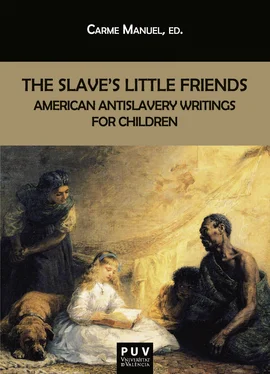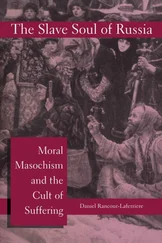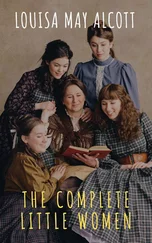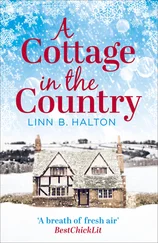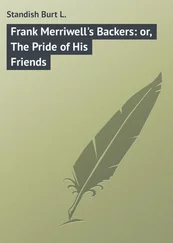1 ...8 9 10 12 13 14 ...29 “ The Slave’s Friend is printed for children. The editor wants to have them love the poor slaves,” declared the first issue, presenting the type of material that would be included. On the one hand, it included a vast array of written material—Biblical citations against slavery, exemplary tales for children, reprinted pieces from well-known antislavery authors (for example, Hannah More’s “The Noble Negro” 3), as well as a rich exhibition of images. Authors’ contributions appeared anonymously, either for the sake of decorum or most probably to protect themselves against the condemnation or even physical violence of non-antislavery compatriots. As Benjamin Lamb-Books asserts, “Contempt for abolitionism stemmed from how the abolitionists egregiously violated the dominant racial and gender status quo. The very word ‘abolitionist’ to most northerners was loathed, more of an insult in their eyes than a badge of pride” (67).
Each issue included two or three woodcuts, and its illustrations were taken from a large antislavery visual archive, and used repeatedly along the issues. These images depicted the cruelty and the physical tortures perpetrated by slaveholders and overseers towards slave men, women and children, and drew attention to the stark contrast between the brutalities endured by the enslaved and the freedom and comfort of the readers themselves. The magazine tackled all aspects of abuse against slaves and, following a radical abolitionists’ doctrine, believed slavery was a sin and anti-Christian, and promoted moral suasion. Child readers were thus provided with countless examples to be convinced of the evil of the institution and be drawn to sympathize with the enslaved, and convert to abolitionism.
The texts included told about the history of the slave trade, slavery in the United States, letters from black children, the proceedings of juvenile antislavery societies, letters from young readers converted to radical abolitionism, petitions, history of Haiti, reports on antislavery martyrs such as Lovejoy, excerpts from slave narratives, and extracts from well-known books on West Indian emancipation. Moreover, together with the blunt and uncompromising descriptions of cruelty to slaves, the magazine also contained depictions of cruelty to animals. As Spencer D.C. Keralis writes, the equation drawn in The Slave’s Friend between cruelty to enslaved people and cruelty to animals is based on reformist ideas and the doctrine of Christian sympathy, an identification that could be extended both to non-white people and non-human creatures. These pictures, explains Keralis, are “ubiquitous in abolitionist writing in general, but particularly prevalent in texts marketed to children” (122). For Manisha Sinha, “[r]ather than social control, abolitionists’ educational activism displayed a healthy respect for minors as rational, ethical agents” (225). Christopher Geist includes the list of resolutions for appropriate discourse included in the seventh issue in 1836:
RESOLUTIONS
With God’s help I resolve
1. Never to call a colored person A NEGRO. They do not like to be called so; and they think it is calling names .
2. Never to call a colored person, that BLACK FELLOW, or BLACKEY, or DARKEY. It is insulting to call them so .
3. Never to call a colored man a BOY. This is often done, and it is insulting and foolish .
4. To speak to colored people, and of them, just as I do to and of white people.
5. Always to have respectful and kind feelings toward colored people.
British newspaper editor William T. Stead published a biographical article on American women’s suffragist and temperance reformer Frances E. Willard (1839-1898) titled “The Uncrowned Queen of American Democracy. A Character Sketch of Miss Frances E. Willard” in November 1892 ( The Review of Reviews. An International Magazine. American Edition , Vol. I, 427-444). In his portrait of the educator, Stead wrote about the books that had influenced her (433), the Bible and Children’s Pilgrim’s Progress , and recognized that these were not the most crucial for her: “But the life shaping book for her was a little fanatical Sunday school Abolitionist book, entitled The Slave's Friend , Miss Willard says: The Slave's Friend , ‘that earliest book of all my reading, stamped upon me the purpose to help humanity, the sense of brotherhood, of all nations as really one, and of God as the equal Father of all races. This, perhaps, was a better sort of religion than some Sunday school books would have given. It occurs to me that I have not estimated at its true value that nugget of a little fanatical volume published for children by the Anti-Slavery Society.’” Stead explained to his late-nineteenth-century readers that The Slave’s Friend was “a tiny juvenile paper, no larger than a post card, and it was out of this little periodical that Miss Willard was taught to read. One story, ‘Little Daniel,’ impressed her much, and it is easy to see how it influenced her. The Abolitionist hero is represented as being abused as a fanatic, an incendiary, a brawler, a cut-throat and a fool; but, nevertheless, he is the righteous man.” Stead concluded that “[s]uch early reading robbed these epithets of their sting.” And Frances Willard, like most probably many other American reformers, declared: “I owe to that little anti-slavery paper my earliest impulse to philanthropy, and much of my fearlessness as a reformer.”
In 1835 William Lloyd Garrison published JUVENILE POEMS: FOR THE USE OF FREE AMERICAN CHILDREN, OF EVERY COMPLEXION, a compilation of abolitionist pieces that had previously been included in the Juvenile Department of The Liberator , a weekly newspaper that had appeared on January 1, 1831, and published its last issue on December 29, 1865. Founded by Garrison and Isaac Knapp, The Liberator was the most relevant abolitionist publication in antebellum America. In the Preface of Juvenile Poems , Garrison wrote about the aims of his compilation for children and youth. He recognized the failure of his society in “the cause of righteousness or freedom,” highlighted the relevance of education to mold children’s compassionate characters, and drew attention to the urgent need to foster new strategies to counteract racial prejudices and abolish slavery. For Garrison, young Americans were to perform a key role in the creation of a truly free Republic: “All missionary labors, expended upon the manhood of heathenism or oppression, have been of little service to the cause of righteousness or freedom. The only rational, and certainly the most comprehensive plan of redeeming the world speedily from its pollution, is to begin with the infancy of mankind, If, therefore, we desire to see our land delivered from the curse of prejudice and slavery, we must direct our efforts chiefly to the rising generation, whose minds are untainted, whose opinions are unfashioned, and whose sympathies are true to nature in its purity.” This foreword is dated August 20, 1835. The date is important because on October 14, Garrison was the victim of mob violence. George Thompson, the reputed British abolitionist orator and author, was visiting the country, and both of them were scheduled to speak together at a meeting of the Boston Female Anti-Slavery Society. Thompson managed to escape from the rage of the crowd unharmed, but Garrison had to be rescued. The incident illustrates the fierce hostility that abolitionists’ actions and public gatherings drew from their countrymen in that decade.
One of the principal authors favored by Garrison in his newspaper and in this compilation was Elizabeth Margaret Chandler (1807-1834), one of the first women to speak publicly against the institution of slavery and make abolition the central theme of her writings. Chandler was a Quaker and published her essays and poems in Genius of Universal Emancipation , the first American antislavery newspaper, established by Benjamin Lundy in Mt. Pleasant, Ohio, in 1821, the same year that Missouri was admitted to the Union as a slave state. Together with Chandler, Prudence Crandall was her companion in transforming slavery into a women’s issue. When the American Anti-Slavery Society was founded at the end of 1833, even though no women were included as delegates, they were present. Lucrecia Mott and other Quaker women organized the Philadelphia Female Anti-Slavery Society three days later, as a result of their exclusion from the all-male American Anti-Slavery Society. As happened in other reform movements, the antislavery struggle afforded women a space from which they would raise a voice of resistance against the evils of their times without risking their status as respectable true women, as accorded by nineteenth-century liberal gender ideals. In this romantic age, devoted to what Richard S. Newman calls “absolute commitments,” women joined hands with their male reformist partners in what became “a metaphoric war on bondage” (130) through the writing of literature for children.
Читать дальше
